Human Resource Management: Gen Y/Z Talent Attraction Strategies
VerifiedAdded on 2022/08/24
|10
|2276
|29
Report
AI Summary
This report provides a comprehensive analysis of human resource management (HRM) strategies designed to attract and retain both Generation Y (Millennials) and Generation Z talent. It explores contemporary approaches, including changes in management styles, fostering a positive organizational culture, emphasizing meaning and purpose in work, and offering flexible work arrangements. The report also delves into tools for talent acquisition, such as application tracking systems (ATS), candidate relationship management (CRM) software, and interviewing software, highlighting their role in reducing manpower needs. Furthermore, it examines the application of artificial intelligence (AI) and big data in HRM, specifically in performance management and employee development, including the use of learning management systems (LMS) and the need for digital transformation training to equip employees with relevant skills. The report emphasizes the importance of these strategies and tools in creating a modern, effective, and engaging work environment to attract and retain top talent in today's competitive landscape.
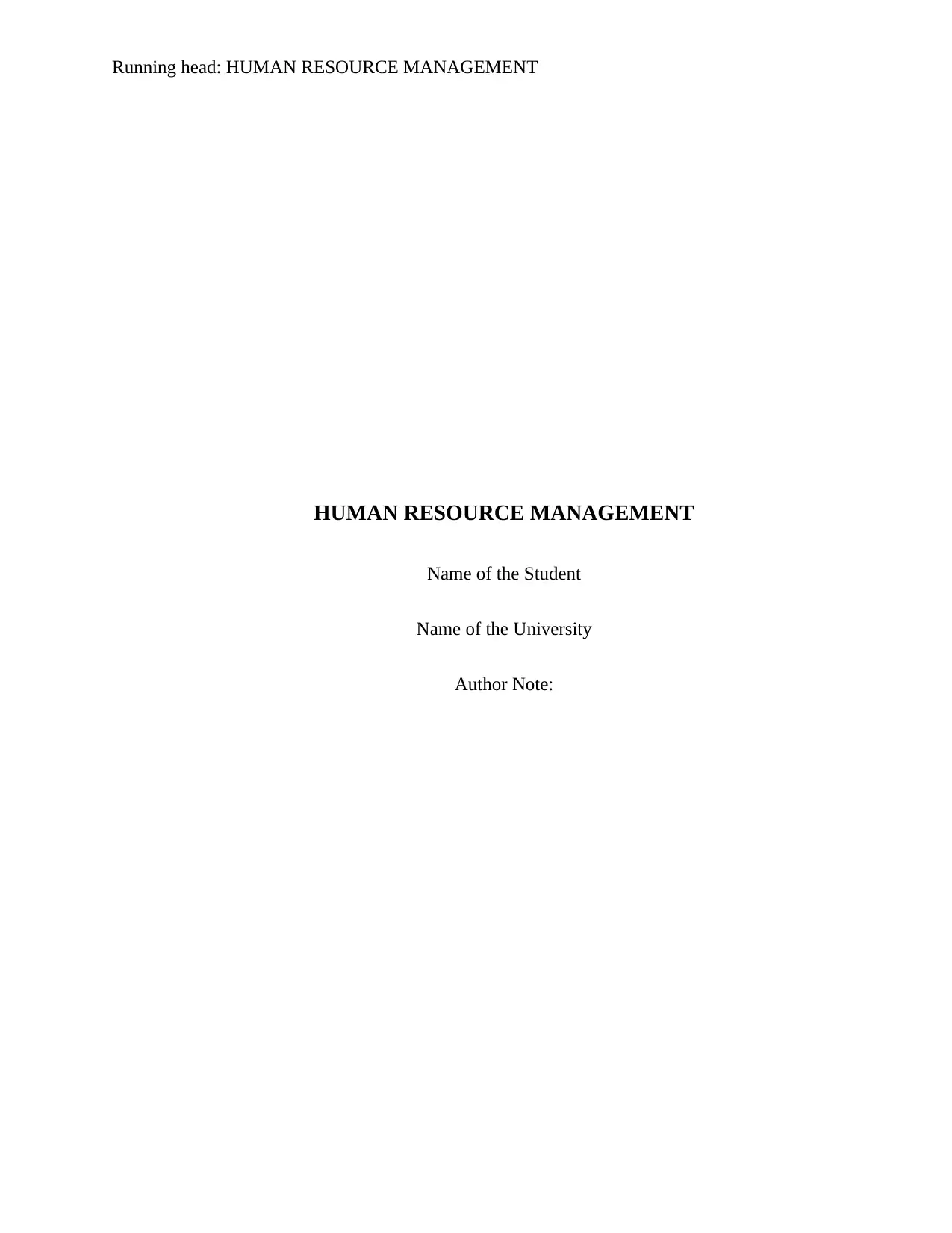
Running head: HUMAN RESOURCE MANAGEMENT
HUMAN RESOURCE MANAGEMENT
Name of the Student
Name of the University
Author Note:
HUMAN RESOURCE MANAGEMENT
Name of the Student
Name of the University
Author Note:
Paraphrase This Document
Need a fresh take? Get an instant paraphrase of this document with our AI Paraphraser
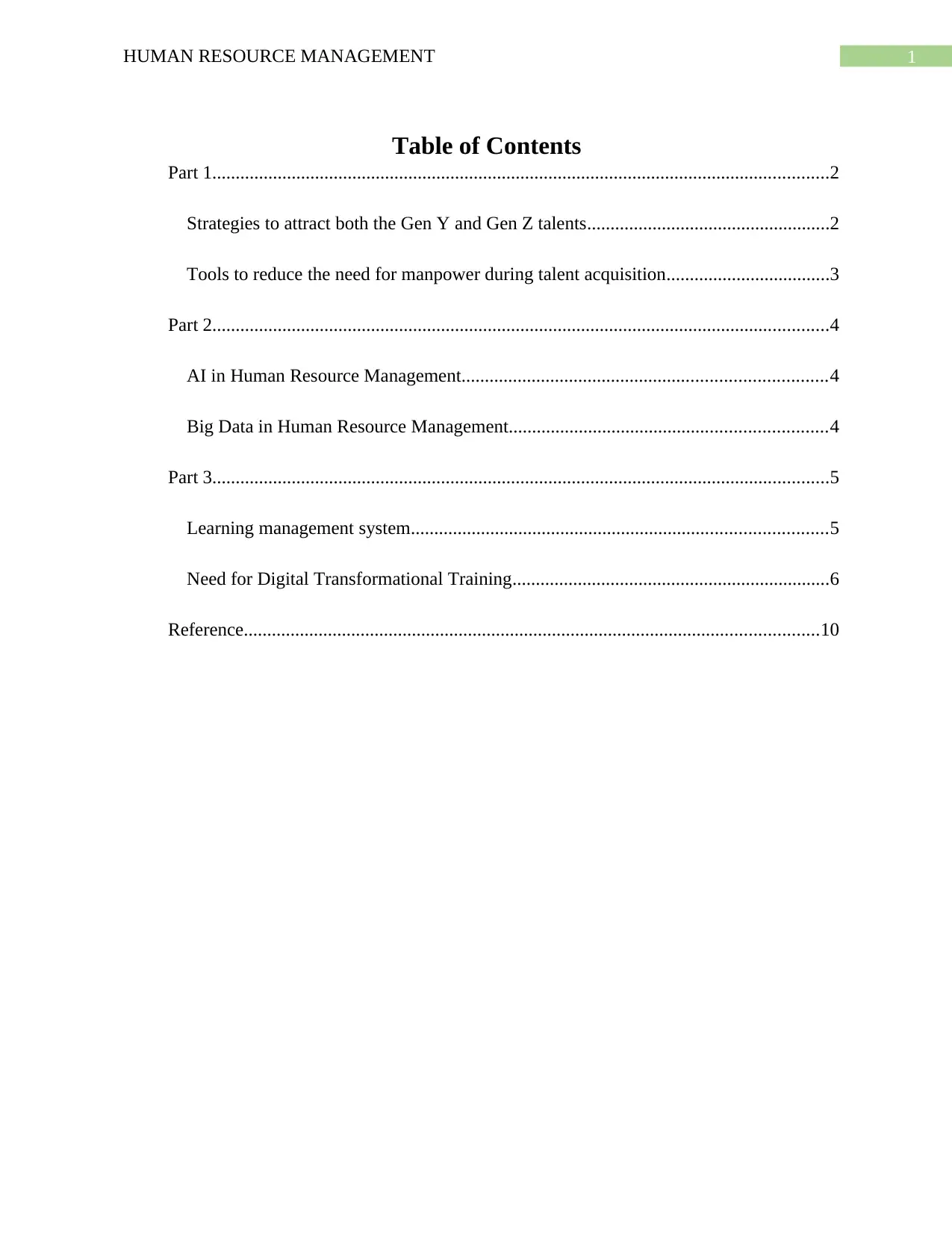
1HUMAN RESOURCE MANAGEMENT
Table of Contents
Part 1....................................................................................................................................2
Strategies to attract both the Gen Y and Gen Z talents....................................................2
Tools to reduce the need for manpower during talent acquisition...................................3
Part 2....................................................................................................................................4
AI in Human Resource Management..............................................................................4
Big Data in Human Resource Management....................................................................4
Part 3....................................................................................................................................5
Learning management system.........................................................................................5
Need for Digital Transformational Training....................................................................6
Reference...........................................................................................................................10
Table of Contents
Part 1....................................................................................................................................2
Strategies to attract both the Gen Y and Gen Z talents....................................................2
Tools to reduce the need for manpower during talent acquisition...................................3
Part 2....................................................................................................................................4
AI in Human Resource Management..............................................................................4
Big Data in Human Resource Management....................................................................4
Part 3....................................................................................................................................5
Learning management system.........................................................................................5
Need for Digital Transformational Training....................................................................6
Reference...........................................................................................................................10
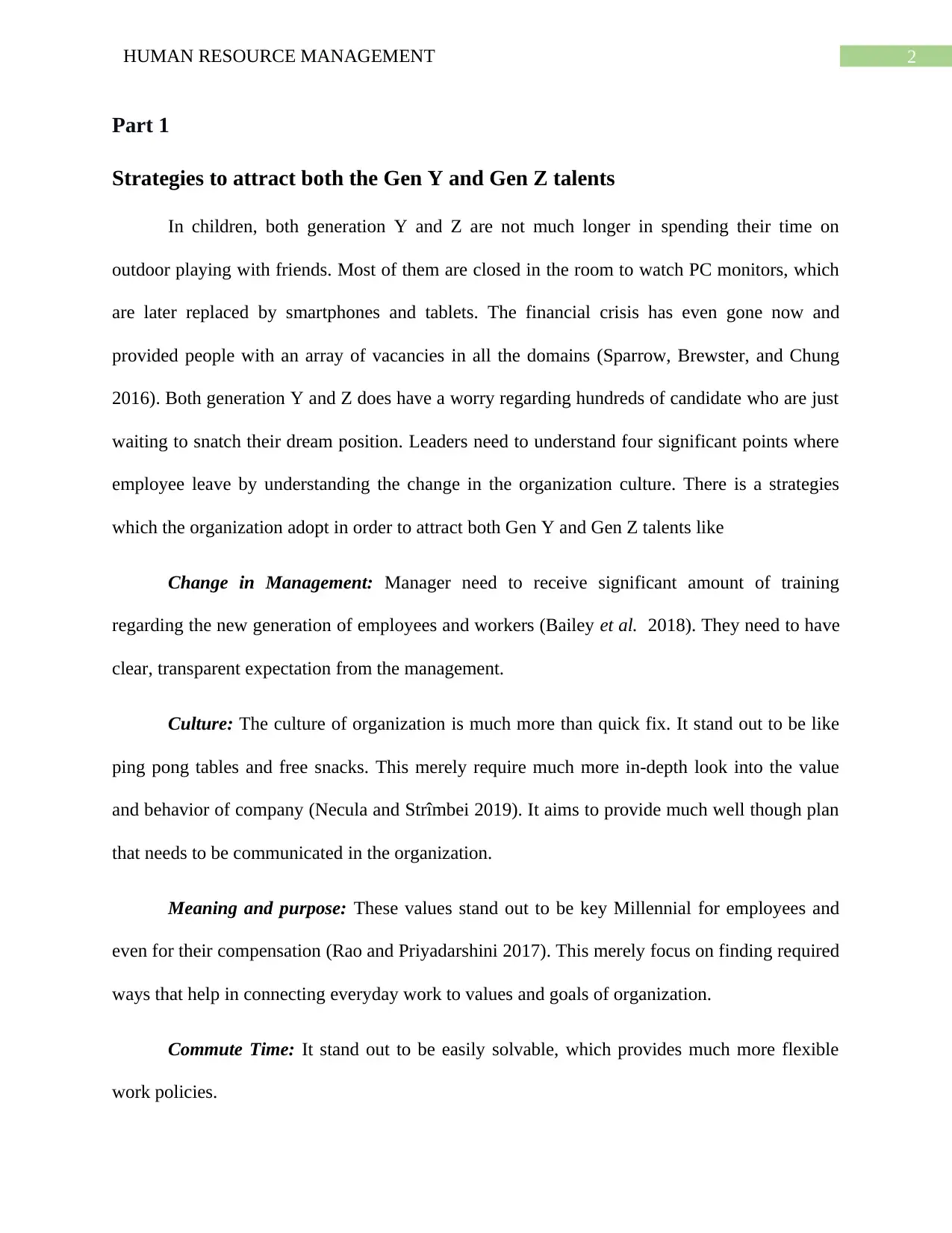
2HUMAN RESOURCE MANAGEMENT
Part 1
Strategies to attract both the Gen Y and Gen Z talents
In children, both generation Y and Z are not much longer in spending their time on
outdoor playing with friends. Most of them are closed in the room to watch PC monitors, which
are later replaced by smartphones and tablets. The financial crisis has even gone now and
provided people with an array of vacancies in all the domains (Sparrow, Brewster, and Chung
2016). Both generation Y and Z does have a worry regarding hundreds of candidate who are just
waiting to snatch their dream position. Leaders need to understand four significant points where
employee leave by understanding the change in the organization culture. There is a strategies
which the organization adopt in order to attract both Gen Y and Gen Z talents like
Change in Management: Manager need to receive significant amount of training
regarding the new generation of employees and workers (Bailey et al. 2018). They need to have
clear, transparent expectation from the management.
Culture: The culture of organization is much more than quick fix. It stand out to be like
ping pong tables and free snacks. This merely require much more in-depth look into the value
and behavior of company (Necula and Strîmbei 2019). It aims to provide much well though plan
that needs to be communicated in the organization.
Meaning and purpose: These values stand out to be key Millennial for employees and
even for their compensation (Rao and Priyadarshini 2017). This merely focus on finding required
ways that help in connecting everyday work to values and goals of organization.
Commute Time: It stand out to be easily solvable, which provides much more flexible
work policies.
Part 1
Strategies to attract both the Gen Y and Gen Z talents
In children, both generation Y and Z are not much longer in spending their time on
outdoor playing with friends. Most of them are closed in the room to watch PC monitors, which
are later replaced by smartphones and tablets. The financial crisis has even gone now and
provided people with an array of vacancies in all the domains (Sparrow, Brewster, and Chung
2016). Both generation Y and Z does have a worry regarding hundreds of candidate who are just
waiting to snatch their dream position. Leaders need to understand four significant points where
employee leave by understanding the change in the organization culture. There is a strategies
which the organization adopt in order to attract both Gen Y and Gen Z talents like
Change in Management: Manager need to receive significant amount of training
regarding the new generation of employees and workers (Bailey et al. 2018). They need to have
clear, transparent expectation from the management.
Culture: The culture of organization is much more than quick fix. It stand out to be like
ping pong tables and free snacks. This merely require much more in-depth look into the value
and behavior of company (Necula and Strîmbei 2019). It aims to provide much well though plan
that needs to be communicated in the organization.
Meaning and purpose: These values stand out to be key Millennial for employees and
even for their compensation (Rao and Priyadarshini 2017). This merely focus on finding required
ways that help in connecting everyday work to values and goals of organization.
Commute Time: It stand out to be easily solvable, which provides much more flexible
work policies.
⊘ This is a preview!⊘
Do you want full access?
Subscribe today to unlock all pages.

Trusted by 1+ million students worldwide
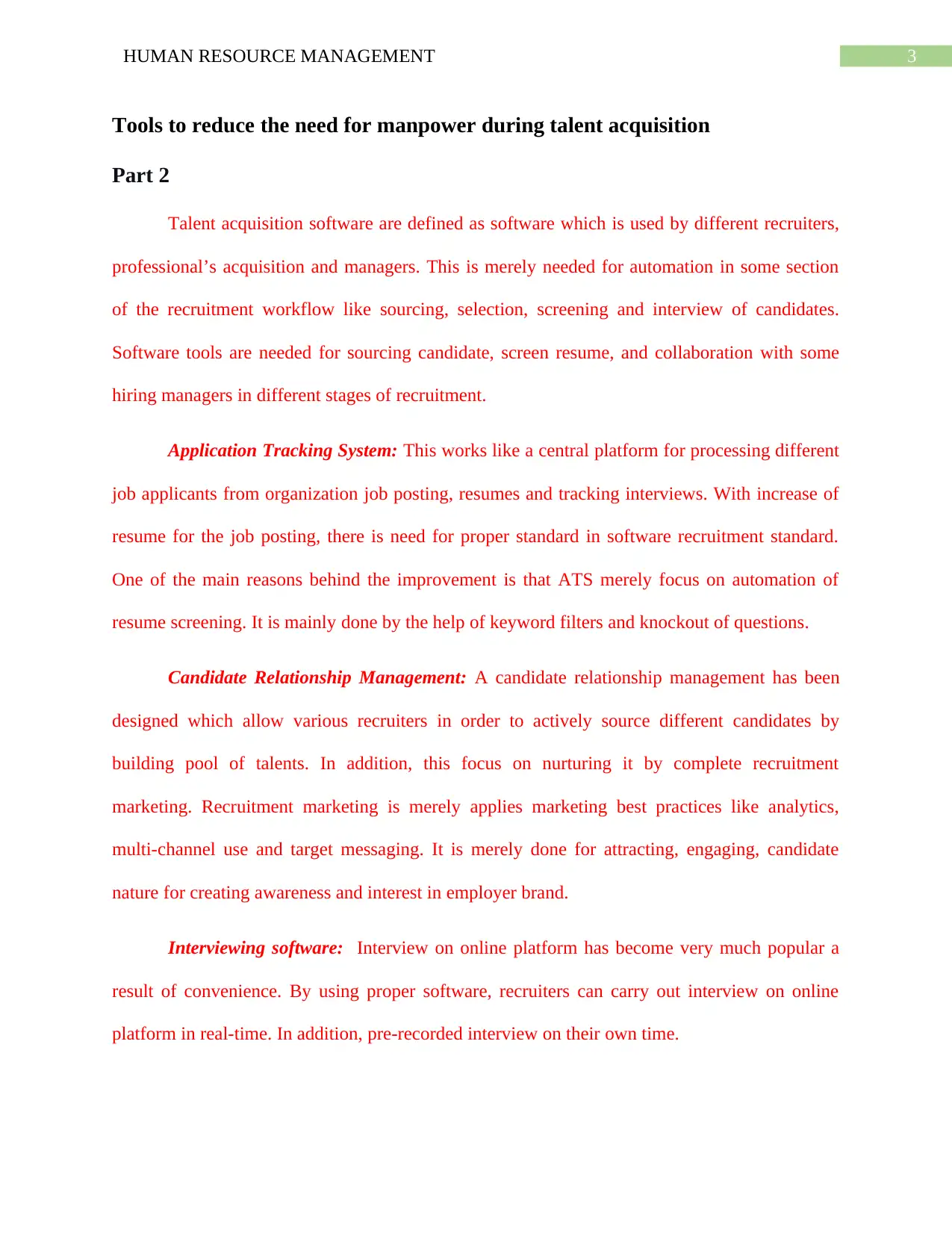
3HUMAN RESOURCE MANAGEMENT
Tools to reduce the need for manpower during talent acquisition
Part 2
Talent acquisition software are defined as software which is used by different recruiters,
professional’s acquisition and managers. This is merely needed for automation in some section
of the recruitment workflow like sourcing, selection, screening and interview of candidates.
Software tools are needed for sourcing candidate, screen resume, and collaboration with some
hiring managers in different stages of recruitment.
Application Tracking System: This works like a central platform for processing different
job applicants from organization job posting, resumes and tracking interviews. With increase of
resume for the job posting, there is need for proper standard in software recruitment standard.
One of the main reasons behind the improvement is that ATS merely focus on automation of
resume screening. It is mainly done by the help of keyword filters and knockout of questions.
Candidate Relationship Management: A candidate relationship management has been
designed which allow various recruiters in order to actively source different candidates by
building pool of talents. In addition, this focus on nurturing it by complete recruitment
marketing. Recruitment marketing is merely applies marketing best practices like analytics,
multi-channel use and target messaging. It is merely done for attracting, engaging, candidate
nature for creating awareness and interest in employer brand.
Interviewing software: Interview on online platform has become very much popular a
result of convenience. By using proper software, recruiters can carry out interview on online
platform in real-time. In addition, pre-recorded interview on their own time.
Tools to reduce the need for manpower during talent acquisition
Part 2
Talent acquisition software are defined as software which is used by different recruiters,
professional’s acquisition and managers. This is merely needed for automation in some section
of the recruitment workflow like sourcing, selection, screening and interview of candidates.
Software tools are needed for sourcing candidate, screen resume, and collaboration with some
hiring managers in different stages of recruitment.
Application Tracking System: This works like a central platform for processing different
job applicants from organization job posting, resumes and tracking interviews. With increase of
resume for the job posting, there is need for proper standard in software recruitment standard.
One of the main reasons behind the improvement is that ATS merely focus on automation of
resume screening. It is mainly done by the help of keyword filters and knockout of questions.
Candidate Relationship Management: A candidate relationship management has been
designed which allow various recruiters in order to actively source different candidates by
building pool of talents. In addition, this focus on nurturing it by complete recruitment
marketing. Recruitment marketing is merely applies marketing best practices like analytics,
multi-channel use and target messaging. It is merely done for attracting, engaging, candidate
nature for creating awareness and interest in employer brand.
Interviewing software: Interview on online platform has become very much popular a
result of convenience. By using proper software, recruiters can carry out interview on online
platform in real-time. In addition, pre-recorded interview on their own time.
Paraphrase This Document
Need a fresh take? Get an instant paraphrase of this document with our AI Paraphraser
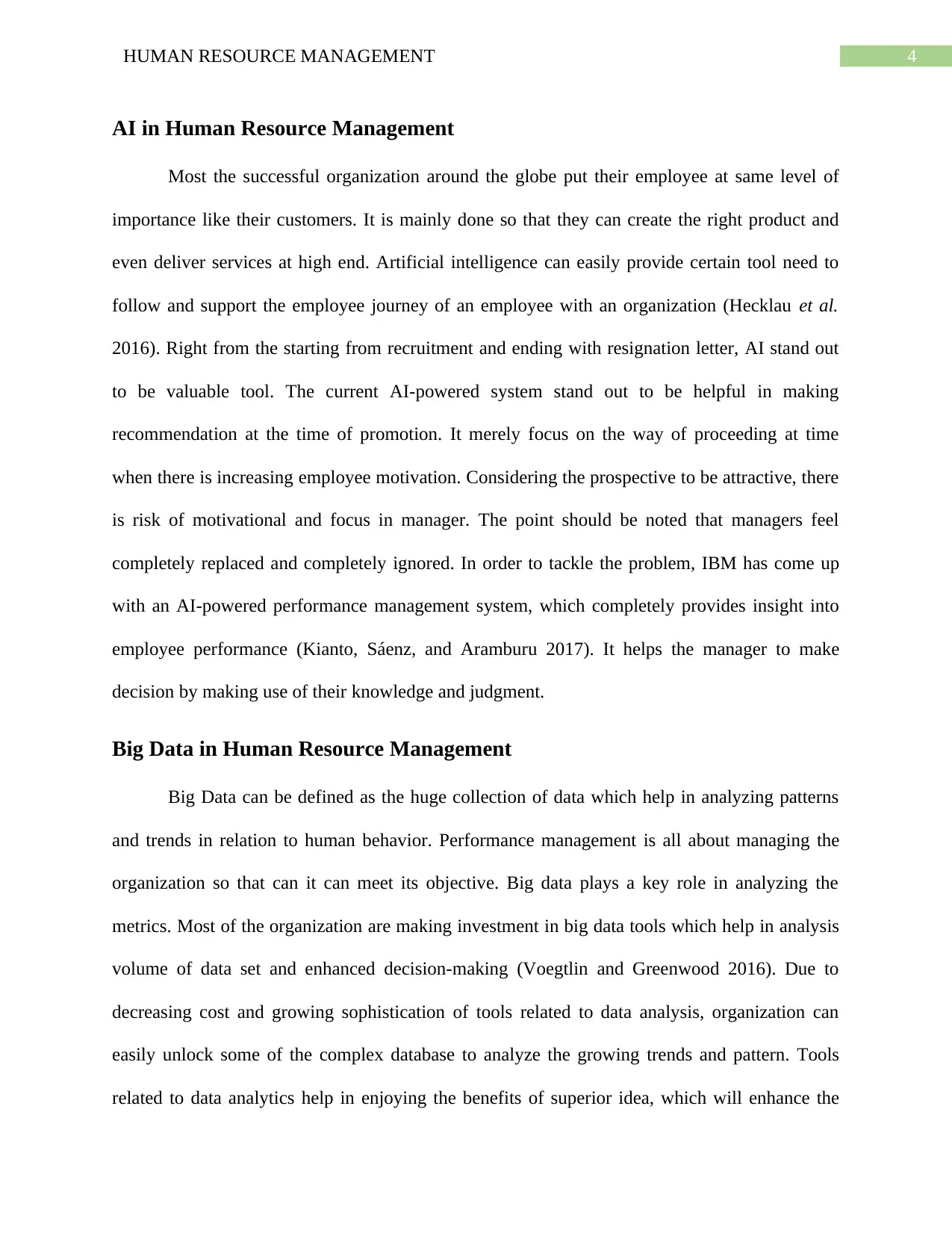
4HUMAN RESOURCE MANAGEMENT
AI in Human Resource Management
Most the successful organization around the globe put their employee at same level of
importance like their customers. It is mainly done so that they can create the right product and
even deliver services at high end. Artificial intelligence can easily provide certain tool need to
follow and support the employee journey of an employee with an organization (Hecklau et al.
2016). Right from the starting from recruitment and ending with resignation letter, AI stand out
to be valuable tool. The current AI-powered system stand out to be helpful in making
recommendation at the time of promotion. It merely focus on the way of proceeding at time
when there is increasing employee motivation. Considering the prospective to be attractive, there
is risk of motivational and focus in manager. The point should be noted that managers feel
completely replaced and completely ignored. In order to tackle the problem, IBM has come up
with an AI-powered performance management system, which completely provides insight into
employee performance (Kianto, Sáenz, and Aramburu 2017). It helps the manager to make
decision by making use of their knowledge and judgment.
Big Data in Human Resource Management
Big Data can be defined as the huge collection of data which help in analyzing patterns
and trends in relation to human behavior. Performance management is all about managing the
organization so that can it can meet its objective. Big data plays a key role in analyzing the
metrics. Most of the organization are making investment in big data tools which help in analysis
volume of data set and enhanced decision-making (Voegtlin and Greenwood 2016). Due to
decreasing cost and growing sophistication of tools related to data analysis, organization can
easily unlock some of the complex database to analyze the growing trends and pattern. Tools
related to data analytics help in enjoying the benefits of superior idea, which will enhance the
AI in Human Resource Management
Most the successful organization around the globe put their employee at same level of
importance like their customers. It is mainly done so that they can create the right product and
even deliver services at high end. Artificial intelligence can easily provide certain tool need to
follow and support the employee journey of an employee with an organization (Hecklau et al.
2016). Right from the starting from recruitment and ending with resignation letter, AI stand out
to be valuable tool. The current AI-powered system stand out to be helpful in making
recommendation at the time of promotion. It merely focus on the way of proceeding at time
when there is increasing employee motivation. Considering the prospective to be attractive, there
is risk of motivational and focus in manager. The point should be noted that managers feel
completely replaced and completely ignored. In order to tackle the problem, IBM has come up
with an AI-powered performance management system, which completely provides insight into
employee performance (Kianto, Sáenz, and Aramburu 2017). It helps the manager to make
decision by making use of their knowledge and judgment.
Big Data in Human Resource Management
Big Data can be defined as the huge collection of data which help in analyzing patterns
and trends in relation to human behavior. Performance management is all about managing the
organization so that can it can meet its objective. Big data plays a key role in analyzing the
metrics. Most of the organization are making investment in big data tools which help in analysis
volume of data set and enhanced decision-making (Voegtlin and Greenwood 2016). Due to
decreasing cost and growing sophistication of tools related to data analysis, organization can
easily unlock some of the complex database to analyze the growing trends and pattern. Tools
related to data analytics help in enjoying the benefits of superior idea, which will enhance the
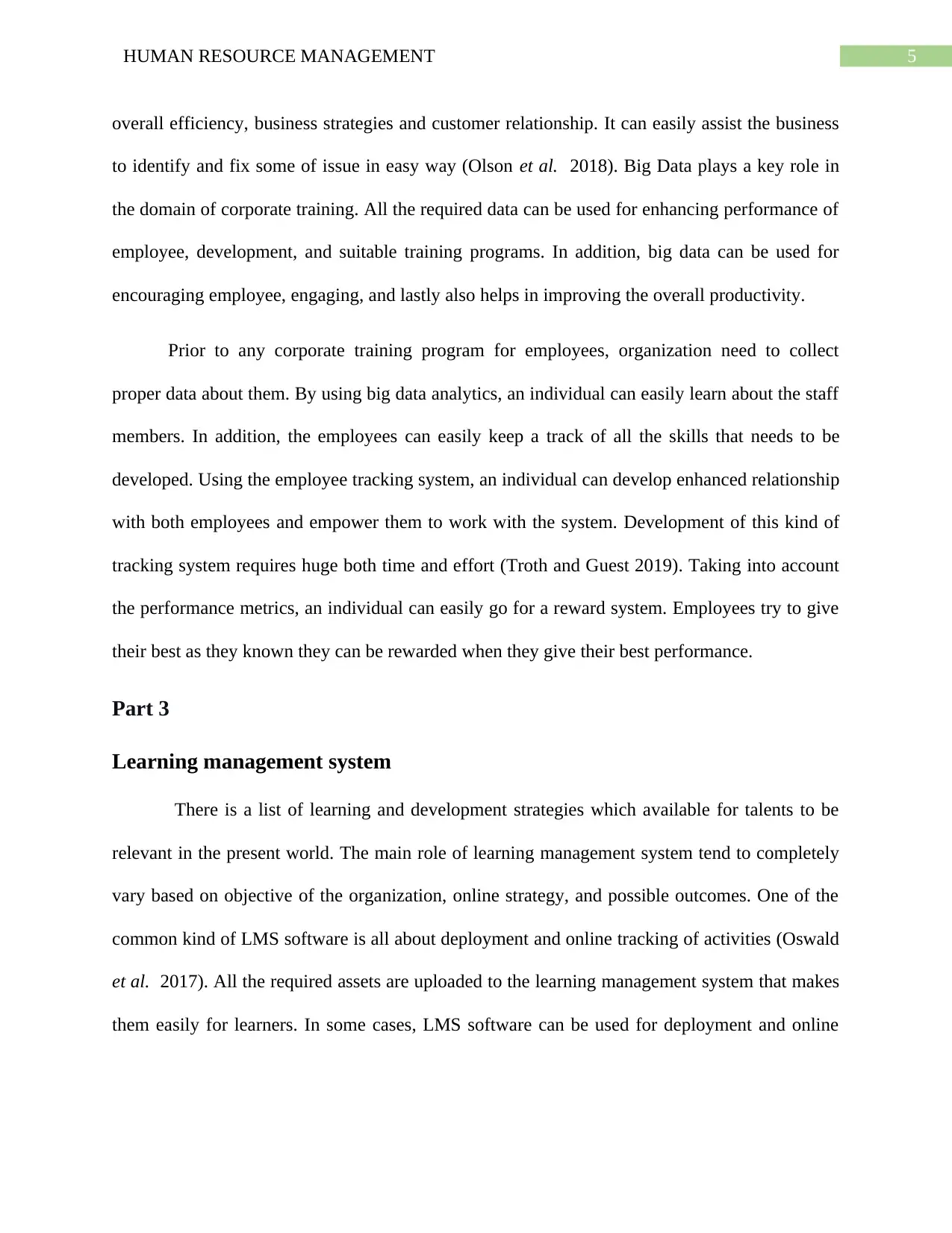
5HUMAN RESOURCE MANAGEMENT
overall efficiency, business strategies and customer relationship. It can easily assist the business
to identify and fix some of issue in easy way (Olson et al. 2018). Big Data plays a key role in
the domain of corporate training. All the required data can be used for enhancing performance of
employee, development, and suitable training programs. In addition, big data can be used for
encouraging employee, engaging, and lastly also helps in improving the overall productivity.
Prior to any corporate training program for employees, organization need to collect
proper data about them. By using big data analytics, an individual can easily learn about the staff
members. In addition, the employees can easily keep a track of all the skills that needs to be
developed. Using the employee tracking system, an individual can develop enhanced relationship
with both employees and empower them to work with the system. Development of this kind of
tracking system requires huge both time and effort (Troth and Guest 2019). Taking into account
the performance metrics, an individual can easily go for a reward system. Employees try to give
their best as they known they can be rewarded when they give their best performance.
Part 3
Learning management system
There is a list of learning and development strategies which available for talents to be
relevant in the present world. The main role of learning management system tend to completely
vary based on objective of the organization, online strategy, and possible outcomes. One of the
common kind of LMS software is all about deployment and online tracking of activities (Oswald
et al. 2017). All the required assets are uploaded to the learning management system that makes
them easily for learners. In some cases, LMS software can be used for deployment and online
overall efficiency, business strategies and customer relationship. It can easily assist the business
to identify and fix some of issue in easy way (Olson et al. 2018). Big Data plays a key role in
the domain of corporate training. All the required data can be used for enhancing performance of
employee, development, and suitable training programs. In addition, big data can be used for
encouraging employee, engaging, and lastly also helps in improving the overall productivity.
Prior to any corporate training program for employees, organization need to collect
proper data about them. By using big data analytics, an individual can easily learn about the staff
members. In addition, the employees can easily keep a track of all the skills that needs to be
developed. Using the employee tracking system, an individual can develop enhanced relationship
with both employees and empower them to work with the system. Development of this kind of
tracking system requires huge both time and effort (Troth and Guest 2019). Taking into account
the performance metrics, an individual can easily go for a reward system. Employees try to give
their best as they known they can be rewarded when they give their best performance.
Part 3
Learning management system
There is a list of learning and development strategies which available for talents to be
relevant in the present world. The main role of learning management system tend to completely
vary based on objective of the organization, online strategy, and possible outcomes. One of the
common kind of LMS software is all about deployment and online tracking of activities (Oswald
et al. 2017). All the required assets are uploaded to the learning management system that makes
them easily for learners. In some cases, LMS software can be used for deployment and online
⊘ This is a preview!⊘
Do you want full access?
Subscribe today to unlock all pages.

Trusted by 1+ million students worldwide
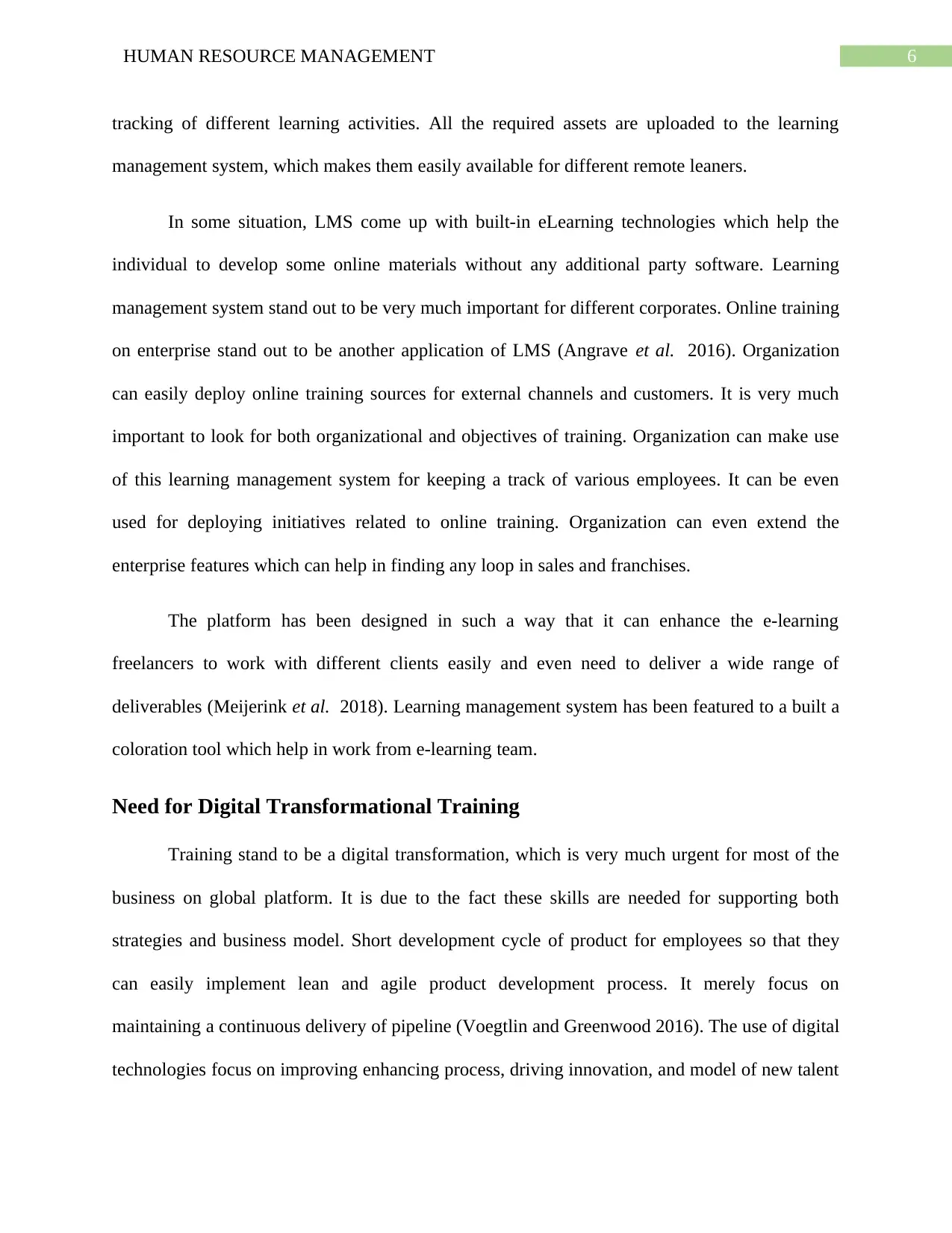
6HUMAN RESOURCE MANAGEMENT
tracking of different learning activities. All the required assets are uploaded to the learning
management system, which makes them easily available for different remote leaners.
In some situation, LMS come up with built-in eLearning technologies which help the
individual to develop some online materials without any additional party software. Learning
management system stand out to be very much important for different corporates. Online training
on enterprise stand out to be another application of LMS (Angrave et al. 2016). Organization
can easily deploy online training sources for external channels and customers. It is very much
important to look for both organizational and objectives of training. Organization can make use
of this learning management system for keeping a track of various employees. It can be even
used for deploying initiatives related to online training. Organization can even extend the
enterprise features which can help in finding any loop in sales and franchises.
The platform has been designed in such a way that it can enhance the e-learning
freelancers to work with different clients easily and even need to deliver a wide range of
deliverables (Meijerink et al. 2018). Learning management system has been featured to a built a
coloration tool which help in work from e-learning team.
Need for Digital Transformational Training
Training stand to be a digital transformation, which is very much urgent for most of the
business on global platform. It is due to the fact these skills are needed for supporting both
strategies and business model. Short development cycle of product for employees so that they
can easily implement lean and agile product development process. It merely focus on
maintaining a continuous delivery of pipeline (Voegtlin and Greenwood 2016). The use of digital
technologies focus on improving enhancing process, driving innovation, and model of new talent
tracking of different learning activities. All the required assets are uploaded to the learning
management system, which makes them easily available for different remote leaners.
In some situation, LMS come up with built-in eLearning technologies which help the
individual to develop some online materials without any additional party software. Learning
management system stand out to be very much important for different corporates. Online training
on enterprise stand out to be another application of LMS (Angrave et al. 2016). Organization
can easily deploy online training sources for external channels and customers. It is very much
important to look for both organizational and objectives of training. Organization can make use
of this learning management system for keeping a track of various employees. It can be even
used for deploying initiatives related to online training. Organization can even extend the
enterprise features which can help in finding any loop in sales and franchises.
The platform has been designed in such a way that it can enhance the e-learning
freelancers to work with different clients easily and even need to deliver a wide range of
deliverables (Meijerink et al. 2018). Learning management system has been featured to a built a
coloration tool which help in work from e-learning team.
Need for Digital Transformational Training
Training stand to be a digital transformation, which is very much urgent for most of the
business on global platform. It is due to the fact these skills are needed for supporting both
strategies and business model. Short development cycle of product for employees so that they
can easily implement lean and agile product development process. It merely focus on
maintaining a continuous delivery of pipeline (Voegtlin and Greenwood 2016). The use of digital
technologies focus on improving enhancing process, driving innovation, and model of new talent
Paraphrase This Document
Need a fresh take? Get an instant paraphrase of this document with our AI Paraphraser
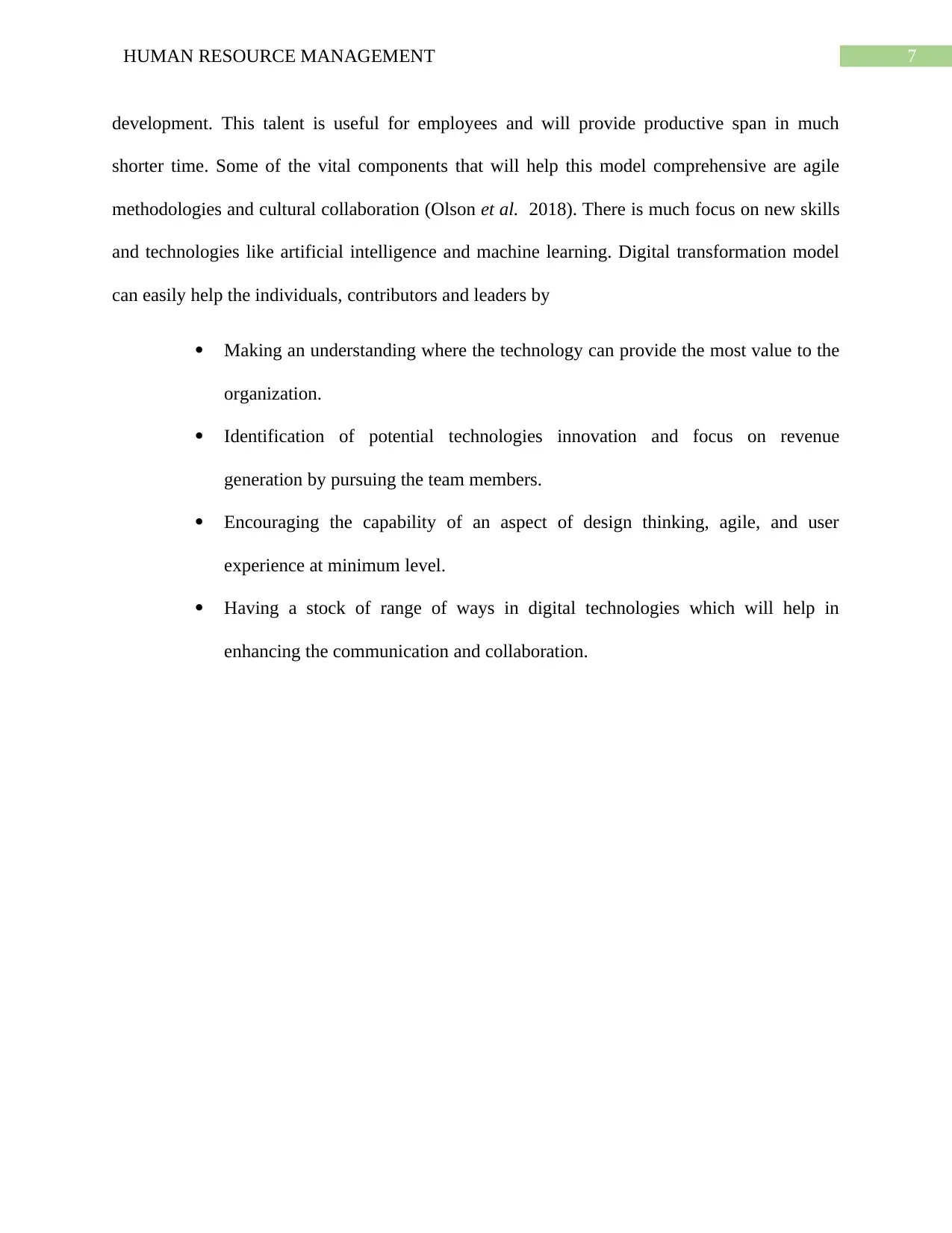
7HUMAN RESOURCE MANAGEMENT
development. This talent is useful for employees and will provide productive span in much
shorter time. Some of the vital components that will help this model comprehensive are agile
methodologies and cultural collaboration (Olson et al. 2018). There is much focus on new skills
and technologies like artificial intelligence and machine learning. Digital transformation model
can easily help the individuals, contributors and leaders by
Making an understanding where the technology can provide the most value to the
organization.
Identification of potential technologies innovation and focus on revenue
generation by pursuing the team members.
Encouraging the capability of an aspect of design thinking, agile, and user
experience at minimum level.
Having a stock of range of ways in digital technologies which will help in
enhancing the communication and collaboration.
development. This talent is useful for employees and will provide productive span in much
shorter time. Some of the vital components that will help this model comprehensive are agile
methodologies and cultural collaboration (Olson et al. 2018). There is much focus on new skills
and technologies like artificial intelligence and machine learning. Digital transformation model
can easily help the individuals, contributors and leaders by
Making an understanding where the technology can provide the most value to the
organization.
Identification of potential technologies innovation and focus on revenue
generation by pursuing the team members.
Encouraging the capability of an aspect of design thinking, agile, and user
experience at minimum level.
Having a stock of range of ways in digital technologies which will help in
enhancing the communication and collaboration.
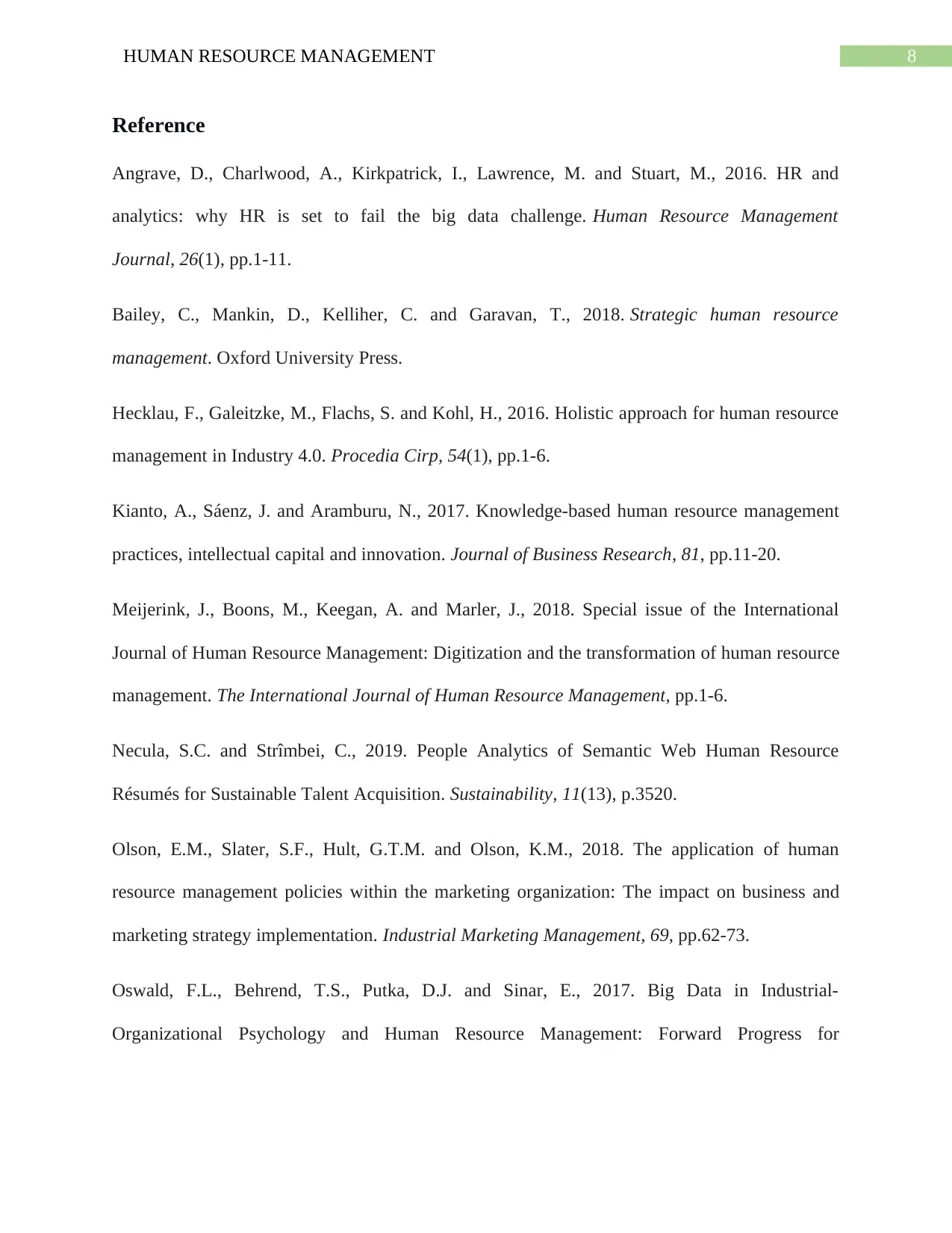
8HUMAN RESOURCE MANAGEMENT
Reference
Angrave, D., Charlwood, A., Kirkpatrick, I., Lawrence, M. and Stuart, M., 2016. HR and
analytics: why HR is set to fail the big data challenge. Human Resource Management
Journal, 26(1), pp.1-11.
Bailey, C., Mankin, D., Kelliher, C. and Garavan, T., 2018. Strategic human resource
management. Oxford University Press.
Hecklau, F., Galeitzke, M., Flachs, S. and Kohl, H., 2016. Holistic approach for human resource
management in Industry 4.0. Procedia Cirp, 54(1), pp.1-6.
Kianto, A., Sáenz, J. and Aramburu, N., 2017. Knowledge-based human resource management
practices, intellectual capital and innovation. Journal of Business Research, 81, pp.11-20.
Meijerink, J., Boons, M., Keegan, A. and Marler, J., 2018. Special issue of the International
Journal of Human Resource Management: Digitization and the transformation of human resource
management. The International Journal of Human Resource Management, pp.1-6.
Necula, S.C. and Strîmbei, C., 2019. People Analytics of Semantic Web Human Resource
Résumés for Sustainable Talent Acquisition. Sustainability, 11(13), p.3520.
Olson, E.M., Slater, S.F., Hult, G.T.M. and Olson, K.M., 2018. The application of human
resource management policies within the marketing organization: The impact on business and
marketing strategy implementation. Industrial Marketing Management, 69, pp.62-73.
Oswald, F.L., Behrend, T.S., Putka, D.J. and Sinar, E., 2017. Big Data in Industrial-
Organizational Psychology and Human Resource Management: Forward Progress for
Reference
Angrave, D., Charlwood, A., Kirkpatrick, I., Lawrence, M. and Stuart, M., 2016. HR and
analytics: why HR is set to fail the big data challenge. Human Resource Management
Journal, 26(1), pp.1-11.
Bailey, C., Mankin, D., Kelliher, C. and Garavan, T., 2018. Strategic human resource
management. Oxford University Press.
Hecklau, F., Galeitzke, M., Flachs, S. and Kohl, H., 2016. Holistic approach for human resource
management in Industry 4.0. Procedia Cirp, 54(1), pp.1-6.
Kianto, A., Sáenz, J. and Aramburu, N., 2017. Knowledge-based human resource management
practices, intellectual capital and innovation. Journal of Business Research, 81, pp.11-20.
Meijerink, J., Boons, M., Keegan, A. and Marler, J., 2018. Special issue of the International
Journal of Human Resource Management: Digitization and the transformation of human resource
management. The International Journal of Human Resource Management, pp.1-6.
Necula, S.C. and Strîmbei, C., 2019. People Analytics of Semantic Web Human Resource
Résumés for Sustainable Talent Acquisition. Sustainability, 11(13), p.3520.
Olson, E.M., Slater, S.F., Hult, G.T.M. and Olson, K.M., 2018. The application of human
resource management policies within the marketing organization: The impact on business and
marketing strategy implementation. Industrial Marketing Management, 69, pp.62-73.
Oswald, F.L., Behrend, T.S., Putka, D.J. and Sinar, E., 2017. Big Data in Industrial-
Organizational Psychology and Human Resource Management: Forward Progress for
⊘ This is a preview!⊘
Do you want full access?
Subscribe today to unlock all pages.

Trusted by 1+ million students worldwide
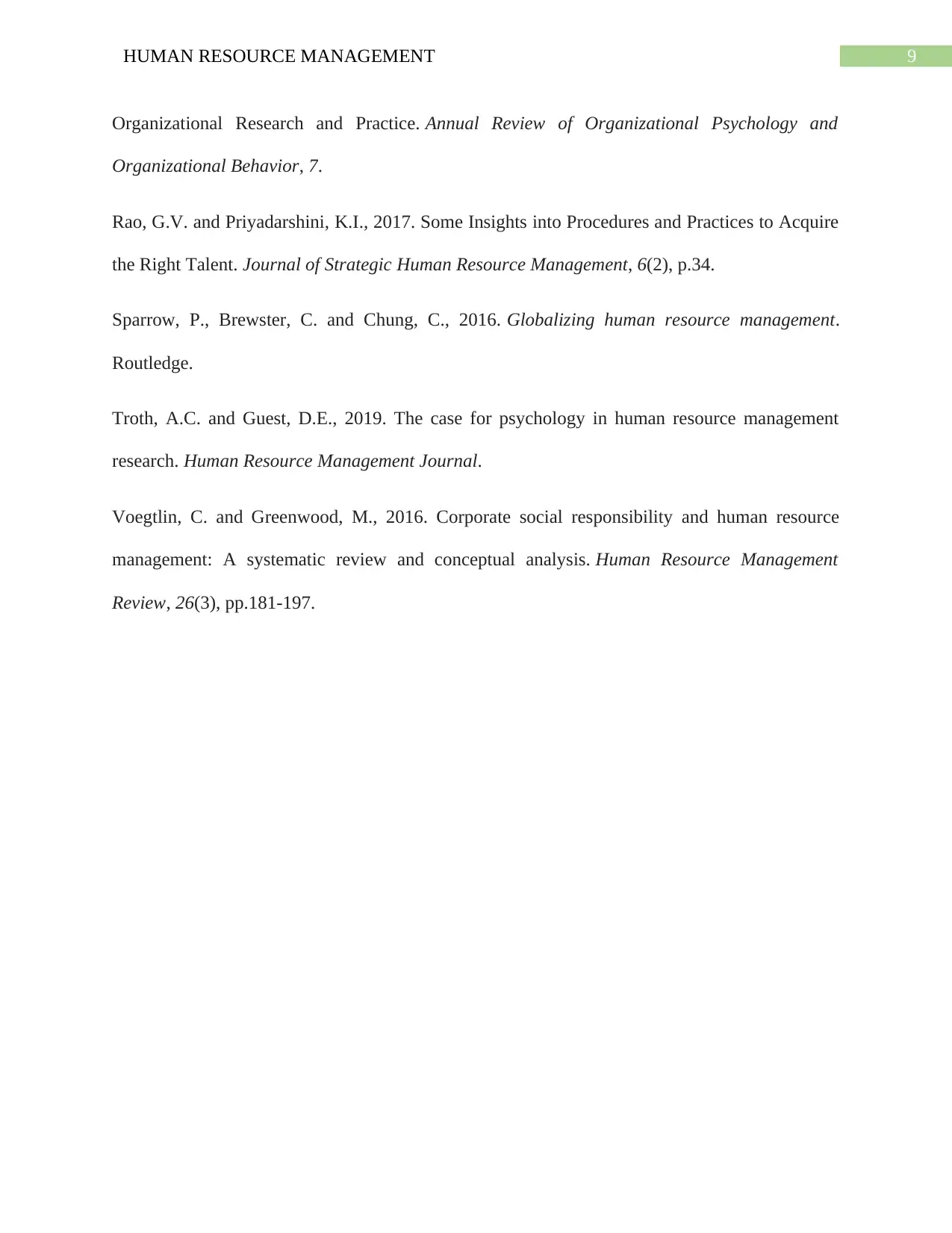
9HUMAN RESOURCE MANAGEMENT
Organizational Research and Practice. Annual Review of Organizational Psychology and
Organizational Behavior, 7.
Rao, G.V. and Priyadarshini, K.I., 2017. Some Insights into Procedures and Practices to Acquire
the Right Talent. Journal of Strategic Human Resource Management, 6(2), p.34.
Sparrow, P., Brewster, C. and Chung, C., 2016. Globalizing human resource management.
Routledge.
Troth, A.C. and Guest, D.E., 2019. The case for psychology in human resource management
research. Human Resource Management Journal.
Voegtlin, C. and Greenwood, M., 2016. Corporate social responsibility and human resource
management: A systematic review and conceptual analysis. Human Resource Management
Review, 26(3), pp.181-197.
Organizational Research and Practice. Annual Review of Organizational Psychology and
Organizational Behavior, 7.
Rao, G.V. and Priyadarshini, K.I., 2017. Some Insights into Procedures and Practices to Acquire
the Right Talent. Journal of Strategic Human Resource Management, 6(2), p.34.
Sparrow, P., Brewster, C. and Chung, C., 2016. Globalizing human resource management.
Routledge.
Troth, A.C. and Guest, D.E., 2019. The case for psychology in human resource management
research. Human Resource Management Journal.
Voegtlin, C. and Greenwood, M., 2016. Corporate social responsibility and human resource
management: A systematic review and conceptual analysis. Human Resource Management
Review, 26(3), pp.181-197.
1 out of 10
Related Documents
Your All-in-One AI-Powered Toolkit for Academic Success.
+13062052269
info@desklib.com
Available 24*7 on WhatsApp / Email
![[object Object]](/_next/static/media/star-bottom.7253800d.svg)
Unlock your academic potential
Copyright © 2020–2025 A2Z Services. All Rights Reserved. Developed and managed by ZUCOL.





